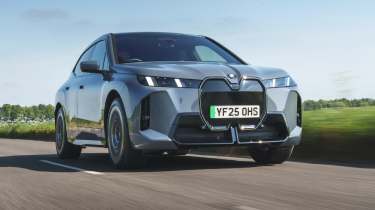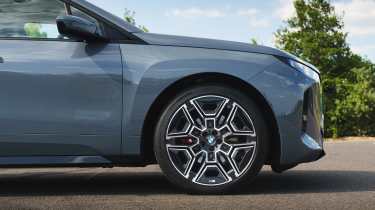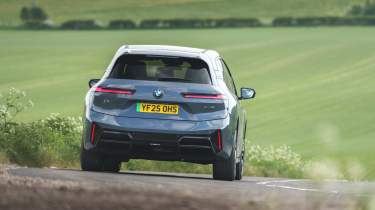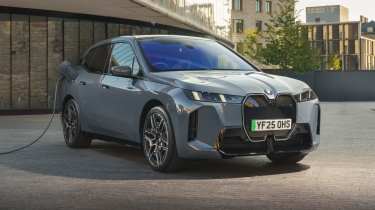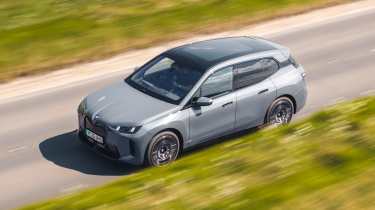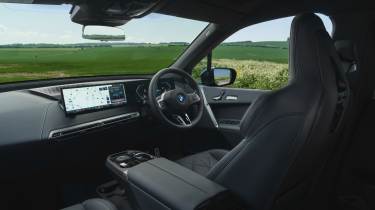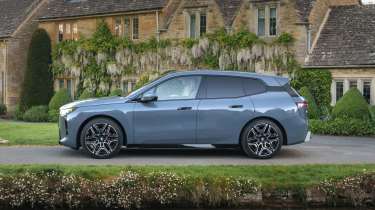BMW iX 2025 review – the ugly duckling still stomps the Tesla Model X
BMW’s electric SUV is as refined to drive as it is challenging to look at and is genuinely impressive for what it is, even if what it is doesn’t appeal to us
Evo verdict
The BMW iX is, in concept at least (and depending on your taste, visually too), an ugly car. Why? Because somewhere in the journey of the motor car, it’s led BMW to establish that its beacon of progress for the EV age must be in the form of something as large and expensive as this huge SUV. So it’s almost annoying that despite our reservation as to its form, the iX still remains one of the best electric cars on sale even four years since its launch, certainly a match for the Porsche Taycan in regards to engineering progress, but with an even more audacious undercurrent to its design, development and execution.
Having been on sale for quite some time now, the iX has received a comprehensive update, improving the performance, range and charging speeds underneath, with a visual nip and tuck on the surface to keep it fresh. Topping the range and replacing the lukewarm M60 is the new M70, now moderately boosted to 650bhp, which we’ll drive at a later date. For now we can bring you impressions of the moderately boosted (in terms of range and power) xDrive60 and the long-range xDrive45, which gains over 100 miles of driving range by comparison to its predecessor.
Engine, gearbox and technical highlights
- Power is up across the range
- Extra range makes the new entry-level iX viable
- Bespoke platform features strategic use of carbonfibre
More reviews
Fundamentals first: the iX is a BMW X5-sized all-electric SUV that’s been designed from the ground up, rather than a mesh of existing BMW underpinnings modified to fit – as in the i4 and iX3. This much is obvious as soon as you open the door, as not only is the floor entirely flat across the whole cabin, but the door sills proudly show off the iX’s strategic use of carbonfibre in the chassis – although not as extensively as the old i3.
With its new platform, BMW emphasised this technical freedom with an unusual set of proportions that err more on the side of ‘minivan’ than ‘tough SUV’ on account of its forward placement of the A-pillars and low beltline. You can make your own mind up about whether you like the way it looks, but fundamentally it’s a design underpinned by an awkward set of proportions that pairs some brilliant detailing (slim lighting, door handles and wheel designs) with rather odd surfacing. The facelift has brought the new canted fang DRLs in its new adaptive LED lights seen across the 3- and 4-series range to make the iX a touch more recognisable as a BMW. Likewise it also gets new vertical, diagonal grille accenting in line with BMW’s current design language. As you’ll have no doubt concluded for yourself, there are some things that no amount of nip and tuck will fix.
The iX is available in three all-wheel drive forms. The 402bhp xDrive45 model opens the range, replacing the 322bhp xDrive40, with a 91kWh battery replacing the 71kWh item in its predecessor. The xDrive60 replaces the xDrive50 in the midground, with a 105kWh battery and 536bhp to play with. The top-spec 611bhp xDrive M60 becomes the M70 with 650bhp, sharing the bigger 105kWh battery pack.
WLTP range figures sit at a high of 426 miles for the xDrive60 and 366 miles in the M70, in prime conditions. While the old entry-level xDrive40 only managed a quoted 264 miles on a charge, the xDrive45 with its much larger battery is claimed to be good for up to 374 miles. In M Sport spec, that drops to 367 miles. BMW claims the improvements in range come in part (as well as from bigger batteries in some models) from reduced bearing friction and a new silica carbide inverter that improves the efficiency of energy flow from the battery to the motors. It’s important to note, though, that BMW’s Neue Klasse tech is still set to improve this by c20 per cent.
Performance and 0-62 time
- 402bhp iX xDrive45 all you really need
- 536bhp xDrive60 adds performance and range
- M70 flagship has 650bhp and 749lb ft
Given its flagship status, you won’t be short on performance no matter the iX model you choose, and the updated car underscores this. The entry-level xDrive45 cars with their boost to 402bhp and 516lb ft are realistically all the iX you’d ever need, with their 0-62mph times shortened by a second to 5.1sec by comparison to the old xDrive40. That puts it well ahead of Audi’s equivalent Q6 e-tron with 383bhp, that achieves a quoted 5.9sec 0-62mph time.
Where the iX range used to jump quite dramatically to the next model in the lineup, the new range sees a more gradual step into the 536bhp xDrive60. The bump in power is more modest and so the 4.6sec quoted 0-62mph time of the old xDrive50 remains.
At the very top of the range is the iX M70, bringing the most standard kit, styling tweaks and a flagship 650bhp power output to the electric SUV. A 0-62mph time of 3.8sec makes it undoubtedly quick, albeit unchanged from the old M60, but the way in which it delivers this performance is still as refined and well measured as the rest of the iX package – opt for comfort mode and it will provide you with the pull you’d expect, but an expertly calibrated throttle map makes it refreshingly easy to drive smoothly.
If you’re after the neck-snapping EV acceleration we’re used to, it can also deliver that. At £114,305, the M70 is £10k cheaper by comparison to the M60 at launch. It also now undercuts its closest rival, the range-topping Mercedes EQE 53 SUV, producing 616bhp for a 3.7sec 0-62mph time, all for £115,130.
Driver’s note
‘BMW has brought the iX right up to par such that the entry-level iX 45 is no longer the apologetic minnow. Realistically, with over 400bhp and over 300 miles of range, it can be all the iX you’d ever realistically need – more than can be said for the old iX 40. The iX 60 is however impressively potent, has more range and has a certain surefootedness at pace along a road over its lesser sibling.’ – Ethan Jupp, evo web editor, who tested the updated iX on the road in the UK.
Efficiency and charging
- Nominal boost in charging speed at base, to 175kW
- Basic iX xDrive45 good for over 300 miles of real world range
- iX 60 and M70 charge at 195kW
The reality of this update for the BMW iX is that it’s all about the entry-level car, which has taken appreciable leaps in terms of range, charging speed and performance. The xDrive45 M Sport we tested is claimed to have up to 367 miles of range, while the slipperier, smaller wheeled Sport spec cars offer up to 374 miles of range. In the real world this should translate to 300 miles of genuine range with normal driving, a big improvement over the old xDrive40. It’ll also charge quicker too, with a 25kW boost to a 175kW maximum charging speed, allowing a claimed 10-80 per cent fillup in 34 minutes.
We also tried the xDrive60 M Sport with its larger battery and claimed range of between 370 and 426 miles. In practice the indicated range of the car from 100 per cent on a fair day is 318 miles which, while significantly lower than the advertised maximum, is absolutely achievable with normal driving. That 426-mile figure is closer to what you’ll see in urban driving, at lower speeds with reduced wind and rolling resistance. The xDrive60 and M70 xDrive will both charge at a maximum speed of 195kW.
Ride and handling
- An exceptional ride plays commendable body control
- The refinement and noise isolation is uncanny
- Steering a little quick
On the move, the iX feels completely effortless, with excellent calibration from both the throttle and brake pedals that make them feel natural and responsive. The steering does have a quick rack, something exaggerated further by the rear-wheel steering, but you quickly acclimatise to it, and thanks to good lateral control the iX never feels uncontrolled or uncouth.
Yet this steadfast body control doesn’t come at the expense of comfort, as even on its largest 22-inch wheel and tyre package the iX rides beautifully on its standard air suspension. It goes beyond just having excellent bump absorption, as there’s also a very clear connection to the road surface. It also doesn’t exhibit any of that subtle shuddering that often afflicts cars on air springs when cornering under load, nor the inability to handle sharp drops in the tarmac as they struggle to react in time.
This is by no means a Porsche Taycan to drive in any of its forms – it’s just too big and heavy to be engaging – but it’s very capable, and never feels anything like as clumsy as a 2510kg SUV should. Factor in its incredible refinement on account of its ability to isolate noise sources such as tyre or road roar, it makes for a brilliant luxury car, not just a brilliant luxury SUV.
Driver’s note
‘What utterly betrays the ignominy of the iX’s polarising design is just how its sheer refinement and comfort bowls you over. I’ve not experienced a quicker transition in a car from sentiments of utter disdain to quiet guilty admiration, than when I first drove an iX. The isolation from wind and tyre noise, the seemingly impenetrable ride quality – you could almost throw a Rolls-Royce body over the thing and call it there.’ – Ethan Jupp, evo web editor, who tested the revised BMW iX on the road in the UK.
Interior and tech
- Retention of rotary controller a masterstroke
- Quality, fit and finish exceptional
- New M70 gets optional more supportive M Sport seats
The interior is a complete triumph – a masterstroke in design and detailing. Its minimal design, not unusual in modern EVs, isn’t defined by what’s missing, but by the few elements that are integrated and their frankly stunning quality. The curved display with its 12.3-inch driver’s display and 14.9-inch central touchscreen remains the dominant element of the interior, mounted clear of the upholstered dash on brackets that look like they could be found in a Frank Gehry foyer.
BMW’s new interfaces within the curved display are very function-heavy and do require some time to understand, but it’s a system that quickly fades into the background once it’s been set up to your individual preferences. Now featuring BMW OS 8.5, the interface is a little more intuitive and now with more features such as video streaming and in-car gaming.
Critically, key elements are all accessible on the centre console’s control grouping, which still features the main click-wheel controller, plus supplementary controls and shortcuts that mean you might never need to use the touchscreen if you’re fingerprint averse.
The materials are just as fascinating – the plant-based leather-like material on our example was soft and lustrous, and paired with a contrasting fabric that together created an interior ambiance unlike that of any rival. New for the updated car are the optional M Sport seats, which do as BMW claims lend a little more support when pressing on a bit harder in the iX, without harming its exemplary comfort and refinement. Being a dedicated EV platform, the interior is spacious with an airy feel, while the boot is suitably huge.
Prices and buying options
The iX range starts from £75,315 for the entry-level xDrive45 model in basic Sport specification. Add £3k to that for the M Sport specification. There used to be a serious incentive to jump up the lineup in order to get more range but now the basic iX has much longer legs than before, with a claimed 321 to 374 miles of range (367 on the big-wheeled M-Sport).
In the middle of the range is the xDrive60 M Sport, for an extra £20k compared to the base car. For this you get a bump in range, to 370 to 426 miles – the longest-legged iX – as well as a jump in power and torque, up to 536bhp from 402bhp and 564lb ft from 516lb ft. For £93,115 this is probably the sweet spot of the iX lineup. Heading the range is of course the iX M70 xDrive with its 650bhp and 749lb ft, though even this is closer in price to the old xDrive50, than the M60 it succeeds, at £114,215.
Ultimately, this is the most important upgrade for the iX as it wades into battle with more rivals than it faced on its introduction in 2022 – much more competitive pricing across the top of the range, and an entry-level model that, while more expensive, is finally a viable option. The amount of standard kit is decent, but for the electrochromic glass roof, laser headlights or (fabulous) Bowers and Wilkins stereo, you’ll need to dip into the options list.
Rivals
Model |
evo rating |
Price |
Kerb weight |
Power |
0-62mph |
|---|---|---|---|---|---|
| BMW iX xDrive60 | 4 | £93,115 | 2580kg | 536bhp | 4.6sec |
| Audi SQ6 | 3.5 | £93,715 | 2425kg | 510bhp (with launch control) | 4.4sec |
| Mercedes EQE 500 | NA | £96,630 | 2550kg | 443bhp | 4.7sec |
| Lotus Eletre | 3.5 | £84,490 | 2490kg | 595bhp | 4.5sec |
As for its rivals, Audi’s e-tron SUV is now off sale, and based on a platform designed for combustion engines that makes it neither as efficient nor variable in its range. A 2025 alternative is the new Q6 e-tron, and while it starts at a lower £61,240, its standard level of kit and performance is far below that of the iX. Increase the budget to £68,145 and the Sport Quattro model is within reach, but the updated iX is now more performant at the entry level, even if it’s still £5k more. Likewise the SQ6, which just pips the middling iX 60 M Sport in terms of performance and price at £93,715, if not range.
The Tesla Model X is the iX’s other potential rival, but thanks to Tesla’s bizarre production cycles, no updated models are due for UK buyers. With the EQC having been discontinued, the EQE SUV is the closest match from Mercedes in 2025, with a near-identical £75,505 starting price, a £115,130 AMG range-topper and comparable performance stats on paper across the range. Coming in from left field is the Lotus Eletre, which is as incongruous and as much a visual statement as the iX, from £84,990 and admittedly, offers more bang for your buck than the comparable iX 60, with 595bhp at base.
